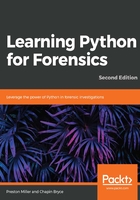
When to use Python
Python is a powerful forensic tool. However, before deciding to develop a script, it is important to consider the type of analysis that's required and the project timeline. In the examples that follow, we will outline situations where Python is invaluable and, conversely, when it is not worth the development effort. Though rapid development makes it easy to deploy a solution in a tough situation, Python is not always the best tool to implement. If a tool exists that performs the task at hand, and is available, it may be the more appropriate method for analysis.
Python is a preferred programming language for forensics due to its ease of use, library support, detailed documentation, and interoperability among operating systems. There are two main types of programming languages: those that are interpreted and those that are compiled. Compiling code allows the programming language to be converted into machine language. This lower-level language is more efficient for the computer to interpret. Interpreted languages are not as fast as compiled languages at runtime, but do not require compilation, which can take some time. Because Python is an interpreted language, we can make modifications to our code and immediately run and view the results. With a compiled language, we would have to wait for our code to re-compile before viewing the effect of our modifications. For this reason, Python may not run as quickly as a compiled language, but allows for rapid prototyping.
An incident response case presents an excellent example of when to use Python in a real-life setting. For example, let's consider that a client calls, panicked, reporting a data breach and is unsure of how many files were exfiltrated over the past 24 hours from their file server. Once on site, you are instructed to perform the fastest count of files accessed in the past 24 hours as this count, and the list of compromised files, will determine the course of action.
Python fits this bill quite nicely here. Armed with just a laptop, you can open a text editor and begin writing a solution. Python can be built and designed without the need for a fancy editor or toolset. The build process of your script may look like this, with each step building upon the previous one:
- Make the script read a single file's last accessed timestamp
- Write a loop that steps through directories and subdirectories
- Test each file to see if that timestamp is from the past 24 hours
- If it has been accessed within 24 hours, then create a list of affected files to display file paths and access times
The process here would result in a script that recurses over the entire server and output files found with a last accessed time in the past 24 hours for manual review. This script will likely be approximately 20 lines of code and have required 10 minutes, or less, for an intermediate scripter to develop and validate—it is apparent this would be more efficient than manually reviewing timestamps on the filesystem.
Before deploying any developed code, it is imperative that you validate its capability first. As Python is not a compiled language, we can easily run the script after adding new lines of code to ensure we haven't broken anything. This approach is known as test-then-code, a method commonly used in script development. Any software, regardless of who wrote it, should be scrutinized and evaluated to ensure accuracy and precision. Validation ensures that the code is operating properly, and although more time-consuming, provides reliable results that are capable of withstanding the courtroom, an important aspect in forensics.
A situation where Python may not be the best tool is for general case analysis. If you are handed a hard drive and asked to find evidence without additional insight, then a pre-existing tool will be the better solution. Python is invaluable for targeted solutions, such as analyzing a given file type and creating a metadata report. Developing a custom all-in-one solution for a given filesystem requires too much time to create when other tools, both paid and free, exist that support such generic analysis.
Python is useful in pre-processing automation. If you find yourself repeating the same tasks for each piece of evidence, it may be worthwhile to develop a system that automates those steps. A great example of suites that perform such analysis is ManTech's analysis and triage system (mantaray: http://github.com/mantarayforensics), which leverages a series of tools to create general reports that can speed up analysis when there is no scope of what data may exist.
When considering whether to commit resources to develop Python scripts, either on the fly or for larger projects, it is important to consider what solutions already exist, the time available to create a solution, and the time saved through automation. Despite best intentions, the development of solutions can go on for much longer than initially conceived without a strong design plan.